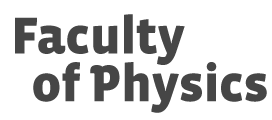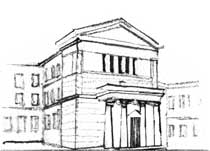Optics Seminar
2006/2007 | 2007/2008 | 2008/2009 | 2009/2010 | 2010/2011 | 2011/2012 | 2012/2013 | 2013/2014 | 2014/2015 | 2015/2016 | 2016/2017 | 2017/2018 | 2018/2019 | 2019/2020 | 2020/2021 | 2021/2022 | 2022/2023 | 2023/2024 | 2024/2025 | Seminar YouTube channel
2011-09-19 (Monday)
Prof. Ian A. Walmsley (Clarendon Laboratory, University of Oxford)
Entang-bling: quantum correlations in diamond
2011-09-06 (Tuesday)
mgr Piotr Szankowski (WF UW)
Nowe spojrzenie na solitony w spinorowym kondensacie Bosego Einsteina
2011-07-19 (Tuesday)
Maria Berdova, (Lappeenranta University of Technology, Finland)
Nanomechanical resonator made out of aluminum membrane
Nowadays one of the significant research goals is the observation of quantum phenomena in macroscopic objects. With the advent of nanomechanical systems experimental studies of quantum behavior has rapidly progressed in recent years. Nanoscale mechanical resonators have oscillations with high frequencies in the range from several MHz to the few GHz, so that it becomes possible with such frequencies to compare thermal energy to the quantum energy and to observe quantum-mechanical phenomena.The requirement for the leaving only zero-point quantum fluctuations is low temperatures which are easily attained in modern cryostats.The present seminar will present an overview of the nanoresonator made out of aluminum membrane: fabrication process, measurement setup and gained results.
2011-06-02 (Thursday)
prof. Henryk Fiedorowicz (WAT)
Projekt europejskiej infrastruktury badawczej Extheme Light Infrastructure ELI
2011-05-26 (Thursday)
mgr Michał Karpiński (IFD UW)
Wysokowydajne falowodowe źródło par fotonów
2011-05-12 (Thursday)
mgr Tomasz Kardaś (Wydział Chemii UW)
Niestabilności niestabilności, czyli chaos jakiego jeszcze nie było w laserze szafirowym
2011-05-05 (Thursday)
dr Wojciech Wasilewski (IFD UW)
Kolektywne rozpraszanie Ramana: generowanie stanów na potrzeby kwantowego przetwarzania informacji
2011-04-28 (Thursday)
prof. Jan Mostowski (IF PAN)
Kondensacja fotonów?
2011-04-21 (Thursday)
mgr Radosław Łapkiewicz (Uniwersytet w Wiedniu)
Experimental non-classicality of an indivisible system
In Quantum Mechanics (QM) not all properties can be simultaneously well> defined. An important question is whether a joint probability> distribution can describe the outcomes of all possible measurements,> allowing a quantum system to be mimicked by classical means. Klyachko et> al. [PRL 101, 020403 (2008)] derived an inequality which allowed us to> answer this question experimentally. The inequality involves only five> measurements and QM predicts its violation for single spin-1 particles.> This is the simplest system where such a contradiction is possible. It> is also indivisible and as such cannot contain entanglement. In our> experiment with single photons distributed among three modes (isomorphic> to stationary spin-1 particles) we obtained a value of -3.893(6), which> lies more than 120 standard deviations below the â€classical’ bound of> -3.081(2).
2011-04-14 (Thursday)
dr Piotr Deuar (IF PAN)







